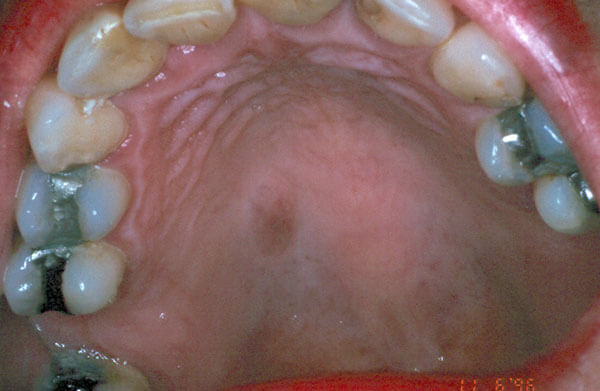Holes In Roof Of Mouth

The roof of the mouth, also known as the palate, is a complex anatomical structure that separates the oral cavity from the nasal cavity. While it’s not uncommon for people to experience minor issues with their palate, such as a slight numbness or sensitivity after a dental procedure, holes in the roof of the mouth can be a more serious concern. In this article, we’ll delve into the possible causes, symptoms, and treatment options for holes in the roof of the mouth.
Causes of Holes in the Roof of the Mouth
There are several possible causes of holes in the roof of the mouth, ranging from congenital conditions to injuries and infections. Some of the most common causes include:
- Cleft Palate: A cleft palate is a congenital condition where the roof of the mouth doesn’t form properly during fetal development, resulting in a hole or gap in the palate. This can occur alone or in combination with a cleft lip.
- Trauma: A blow to the face or a fall can cause a hole in the roof of the mouth, especially if the injury is severe enough to fracture the bones of the palate.
- Infections: Certain infections, such as osteomyelitis or abscesses, can cause holes in the roof of the mouth by damaging the bone and tissue.
- Tumors: Benign or malignant tumors can develop in the roof of the mouth, causing holes or gaps as they grow.
- Surgical Complications: In some cases, holes in the roof of the mouth can occur as a complication of oral surgery, such as a biopsy or tumor removal.
Symptoms of Holes in the Roof of the Mouth
The symptoms of holes in the roof of the mouth can vary depending on the size and location of the hole, as well as the underlying cause. Some common symptoms include:
- Nasal Regurgitation: Food and liquids may flow back into the nasal cavity through the hole, causing discomfort and embarrassment.
- Speech Difficulties: Holes in the roof of the mouth can affect speech, making it difficult to pronounce certain sounds or words.
- Dental Problems: The hole can make it challenging to chew and swallow food, leading to dental problems such as tooth decay or gum disease.
- Pain and Discomfort: Depending on the location and size of the hole, it can cause pain, discomfort, or numbness in the roof of the mouth.
Treatment Options for Holes in the Roof of the Mouth
The treatment for holes in the roof of the mouth depends on the underlying cause and the size and location of the hole. Some common treatment options include:
- Surgery: Surgical repair of the hole may be necessary to close the gap and restore the integrity of the palate.
- Prosthetic Devices: In some cases, a prosthetic device, such as a palatal obturator, may be used to cover the hole and improve speech and swallowing.
- Dental Restorations: Dental restorations, such as crowns or bridges, may be necessary to repair teeth that have been damaged by the hole.
- Speech Therapy: Speech therapy may be recommended to help improve speech and communication skills.
Prevention and Management
While some causes of holes in the roof of the mouth, such as congenital conditions, cannot be prevented, there are steps you can take to reduce the risk of developing holes or gaps in the palate. These include:
- Regular Dental Check-ups: Regular dental check-ups can help identify potential problems early on, reducing the risk of complications.
- Good Oral Hygiene: Practicing good oral hygiene, such as brushing and flossing regularly, can help prevent infections and reduce the risk of holes in the roof of the mouth.
- Avoiding Trauma: Taking steps to avoid trauma, such as wearing a mouthguard during sports or using a seatbelt while driving, can help reduce the risk of holes in the roof of the mouth.
Step-by-Step Guide to Managing Holes in the Roof of the Mouth
- Seek medical attention if you suspect you have a hole in the roof of your mouth.
- Undergo a thorough examination and diagnosis by a qualified healthcare professional.
- Develop a treatment plan with your healthcare provider, which may include surgery, prosthetic devices, or dental restorations.
- Practice good oral hygiene and attend regular dental check-ups to prevent complications.
Conclusion
Holes in the roof of the mouth can be a complex and challenging condition to manage, but with prompt medical attention and effective treatment, it’s possible to improve symptoms and quality of life. By understanding the causes, symptoms, and treatment options for holes in the roof of the mouth, individuals can take the first step towards seeking help and finding relief.
What are the most common causes of holes in the roof of the mouth?
+The most common causes of holes in the roof of the mouth include cleft palate, trauma, infections, tumors, and surgical complications.
How are holes in the roof of the mouth treated?
+Treatment for holes in the roof of the mouth depends on the underlying cause and may include surgery, prosthetic devices, dental restorations, or speech therapy.
Can holes in the roof of the mouth be prevented?
+While some causes of holes in the roof of the mouth cannot be prevented, practicing good oral hygiene, attending regular dental check-ups, and avoiding trauma can help reduce the risk of developing holes or gaps in the palate.
